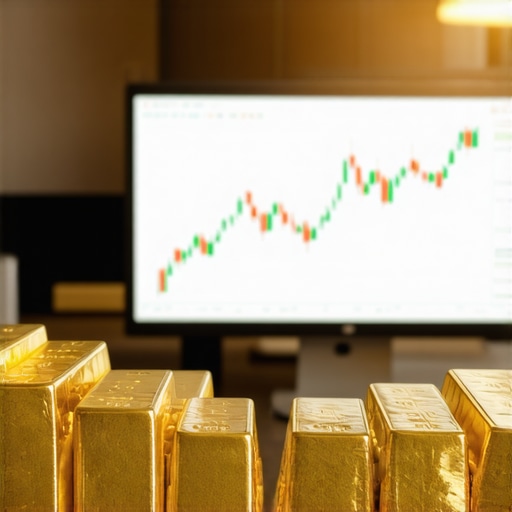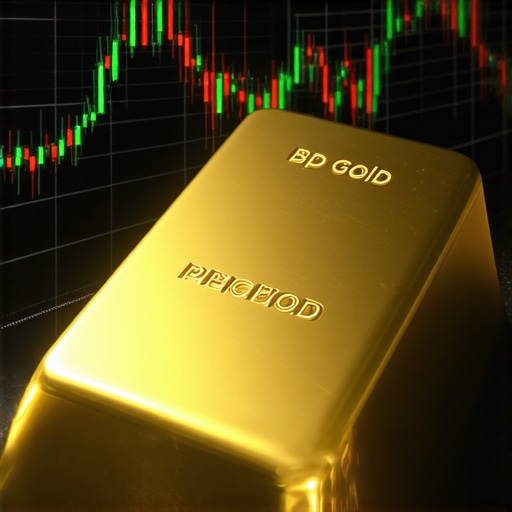Introduction to Gold Price Forecasts: Navigating Future Trends
As an investor, understanding gold price forecasts is crucial for making informed decisions in today’s dynamic market. Gold has always been viewed as a safe haven asset, especially during times of economic uncertainty. With fluctuating global economies, geopolitical tensions, and changing investor sentiments, the demand for gold continues to be a significant indicator of market trends.
Gold price forecasts are influenced by several factors, including supply and demand dynamics, central bank policies, and macroeconomic indicators. Investors looking to navigate the complexities of the gold market must grasp these elements to formulate robust investment strategies.
Key Factors Influencing Gold Prices
Several key factors shape the trajectory of gold prices. Understanding these can provide valuable insights for prospective investors:
1. Economic Indicators and Inflation
Gold often acts as a hedge against inflation. When inflation rates rise, the purchasing power of fiat currencies declines, prompting investors to flock to gold. This trend is particularly pronounced during economic downturns, where uncertainty leads to increased gold demand. For a deeper understanding of this relationship, consider reading about 2025 Gold Price Trends.
2. Central Bank Policies
The actions of central banks around the world play a pivotal role in determining gold prices. When central banks purchase gold, it often signals a desire to diversify their reserves and hedge against currency devaluation. This activity can significantly impact market prices. For more insights, explore how central bank purchases affect prices.
3. Geopolitical Events
Geopolitical tensions can lead to increased demand for gold as a safe haven asset. Events such as conflicts, trade wars, and political instability often drive investors towards gold, leading to price surges. Understanding the implications of these events can help investors time their purchases better. For instance, examining how geopolitical events impact gold prices can provide valuable insights.
4. Market Sentiment and Speculation
Market sentiment, driven by investor perceptions and speculation, can also influence gold prices. If investors believe that gold prices will rise, they may buy more, which can create a self-fulfilling prophecy. Keeping an eye on market sentiment can aid in predicting future price movements.
Understanding Gold Demand Trends
The demand for gold is not only driven by investment but also by its use in jewelry, technology, and industry. As economies grow, the demand for gold in these sectors can impact prices significantly. Analyzing gold demand trends is essential for anticipating price movements.
In conclusion, understanding gold price forecasts involves analyzing a multitude of factors. By considering economic indicators, central bank actions, geopolitical events, and market sentiment, investors can make informed decisions regarding their gold investments. As we delve deeper into the gold market, it becomes evident that having a comprehensive view of these elements is vital for optimizing investment strategies.
Analyzing Gold Supply Dynamics and Their Impact on Prices
The supply of gold is a critical factor in determining its market price. Understanding how gold production levels and mining outputs influence the market can provide investors with a clearer picture of future price movements. For instance, when gold mining production decreases due to challenges such as resource depletion or regulatory constraints, the reduction in supply can lead to price increases. Investors may benefit from monitoring trends in gold mining operations, as these can directly correlate with price fluctuations.
1. The Role of Gold Recycling
Gold recycling is another significant component of the supply equation. As gold prices rise, the incentive for individuals and businesses to sell their old gold increases, adding to the available supply. In times of economic uncertainty, recycled gold can play a substantial role in stabilizing prices. For those interested in understanding the broader implications of gold supply, it’s beneficial to read about gold supply and demand insights.
2. The Influence of Gold Mining Companies
Gold mining companies can significantly impact supply dynamics through their production strategies and exploration activities. Factors such as operational efficiency, geopolitical stability in mining regions, and investment in new technologies can affect their output. Keeping an eye on major players in the gold mining industry is essential for investors looking to gauge future supply conditions.
Global Economic Conditions and Their Effect on Gold Prices
Global economic conditions are paramount when forecasting gold prices. Economic growth or contraction can influence both the demand and supply sides of the equation. For example, during times of economic growth, jewelry and industrial demand for gold may rise. Conversely, in periods of economic recession, demand for gold as a safe haven may increase as investors seek to protect their wealth.
1. The Impact of Interest Rates
Interest rates have a profound effect on gold prices. Lower interest rates can lead to increased gold demand as the opportunity cost of holding gold decreases. Investors often turn to gold when they anticipate that interest rates will remain low or decline further. For insights on how to navigate these changes, consider exploring 2025 gold price trends to understand what lies ahead.
2. Currency Fluctuations and Gold Prices
Gold is typically priced in U.S. dollars, making currency fluctuations another critical factor to consider. A weaker dollar often leads to higher gold prices, as gold becomes cheaper for foreign investors. Understanding the relationship between currency value and gold prices is essential for making informed investment decisions. For more details on this topic, you may find the article analyzing the impact of geopolitical events beneficial.
Technological Advances and Their Influence on Gold Investment
Technological advancements are transforming the gold market, affecting both production and investment strategies. Innovations in mining technology can lead to more efficient extraction processes, potentially increasing supply and affecting prices. Additionally, new trading platforms and investment vehicles, such as gold-backed cryptocurrencies and digital trading platforms, are making gold investments more accessible to a broader audience. Understanding these technological shifts is crucial for investors aiming to optimize their gold portfolios.
As we delve deeper into the intricacies of the gold market, it is essential to consider these multifaceted factors that shape gold price forecasts. Navigating through economic indicators, supply dynamics, and technological advancements will provide investors with a comprehensive understanding of what lies ahead in the gold market.
Technological Innovations Impacting Gold Investment Strategies
As the gold market evolves, technological innovations play a pivotal role in shaping investment strategies. From enhanced mining techniques to digital investment platforms, these advancements are making gold more accessible and potentially more lucrative for investors. Understanding how technology influences the market is essential for anyone looking to capitalize on gold investments.
1. Mining Technology Advancements
Recent advancements in mining technology are revolutionizing gold extraction processes. Innovations such as automated machinery and advanced geological mapping software allow mining companies to increase efficiency and reduce costs. As these technologies become more prevalent, they can lead to a more stable supply of gold. For insights into how mining dynamics affect market prices, check out gold supply and demand insights.
2. Digital Trading Platforms and Accessibility
The rise of digital trading platforms has democratized gold investing, making it easier for everyday investors to participate in the market. These platforms often provide lower transaction fees, real-time pricing, and the ability to trade gold ETFs or mutual funds with just a few clicks. This increased accessibility is likely to drive more investment into gold, which can influence prices positively.
3. The Role of Blockchain in Gold Trading
Blockchain technology is emerging as a game-changer in gold trading, providing enhanced transparency and security. By creating a decentralized ledger for gold transactions, blockchain can help reduce fraud and ensure the authenticity of gold products. Investors may find peace of mind knowing that their investments are backed by verifiable data. For further exploration of how blockchain affects investment strategies, consider reading about understanding gold ETFs and investment strategies.
The Importance of Regulatory Developments in Gold Markets
Regulatory changes also impact how gold is traded and invested in. As governments and financial institutions adapt to new technologies and market conditions, regulations may shift, affecting everything from taxation to compliance requirements for gold transactions. Staying informed about these changes is crucial for investors who want to minimize risks and capitalize on opportunities.
1. Tax Implications for Gold Investments
Understanding the tax implications of gold investments is vital for maximizing returns. Different countries have varying tax rates on gold transactions, which can significantly impact net profits. Investors should consult tax professionals to navigate these complexities and ensure compliance with local regulations. For more guidance on financial planning concerning gold, read 2025 gold market dynamics.
2. Compliance and Reporting Standards
As the gold market becomes more regulated, investors must be aware of compliance and reporting standards that apply to their investments. This can include Know Your Customer (KYC) regulations and anti-money laundering (AML) laws. Familiarizing oneself with these standards can help investors avoid potential legal pitfalls and maintain the integrity of their investments.
Emerging Trends: Gold as an Inflation Hedge
In today’s economic climate, gold is increasingly viewed as a hedge against inflation. As inflation rates rise, the value of currencies may diminish, prompting investors to turn to gold as a store of value. Understanding this dynamic can provide investors with strategic insights into when to buy or sell their gold assets.
1. Historical Performance During Inflationary Periods
Historically, gold has performed well during inflationary periods, often seeing price increases as investor demand rises. Analyzing past trends can equip investors with knowledge about potential future movements. For a deeper understanding of gold’s historical performance, refer to 2025 gold price trends.
2. Investor Sentiment and Market Reactions
Investor sentiment plays a crucial role in gold price fluctuations. During periods of high inflation, market reactions can lead to increased buying pressure, driving prices higher. Monitoring these sentiments and understanding the triggers can enhance an investor’s ability to navigate the gold market effectively. By keeping an eye on key factors impacting gold prices, investors can position themselves advantageously.
Gold as a Long-Term Investment Strategy
When considering gold as part of your investment portfolio, it is essential to view it not just as a short-term asset but as a long-term strategy. Gold has historically proven to be a reliable store of value, offering protection against inflation and currency fluctuations. In this section, we will explore how gold can serve as a cornerstone in a well-diversified investment portfolio.
1. The Role of Gold in Portfolio Diversification
Diversification is a critical principle in investment, and gold plays a significant role in this strategy. By allocating a portion of your portfolio to gold, you can reduce overall risk and volatility. Gold often exhibits a negative correlation with stocks and bonds, meaning that when equity markets are down, gold prices may rise. This characteristic makes gold an attractive option for investors looking to stabilize their portfolios during economic downturns. For more insights on portfolio strategies, read the role of gold in a diversified investment portfolio.
2. Long-Term Performance of Gold
Historically, gold has demonstrated impressive long-term performance, particularly during periods of economic instability. For example, during the 2008 financial crisis, gold prices surged as investors sought safe-haven assets. Understanding the historical performance of gold can help investors make informed decisions about its potential role in their portfolios. To delve deeper into this topic, consider reviewing 2025 gold price trends.
Strategies for Investing in Gold
Investing in gold can take various forms, each with its own advantages and considerations. Understanding these strategies can help you determine the best approach for your investment goals.
1. Physical Gold Investments
Investing in physical gold, such as coins or bars, allows investors to possess a tangible asset. This method provides a sense of security, particularly in times of economic uncertainty. However, it also comes with storage and insurance considerations. For those interested in acquiring physical gold, it’s beneficial to read how to buy gold bullion.
2. Gold Exchange-Traded Funds (ETFs)
Gold ETFs offer a practical way to invest in gold without the need for physical storage. These funds track the price of gold and can be traded on stock exchanges like stocks. They provide liquidity and ease of access, making them a popular choice for many investors. To learn more about these investment vehicles, explore the best gold ETFs for your portfolio.
3. Gold Mutual Funds
Gold mutual funds invest in a diversified portfolio of gold mining companies and related assets. This strategy can provide exposure to gold while also benefiting from the growth potential of mining companies. For insights on how to choose the right gold mutual fund, consider reading the benefits of investing in gold mutual funds.
Conclusion: Preparing for Future Gold Investments
In conclusion, gold remains a vital component for investors seeking to build a resilient portfolio. By understanding its role in diversification, long-term performance, and various investment strategies, you can make informed decisions that align with your financial goals. As we continue to navigate the complexities of the gold market, staying informed about trends and developments will be key to successfully leveraging gold as an investment.
Frequently Asked Questions About Gold Price Forecasts
1. What are the main factors that influence gold prices?
Gold prices are influenced by various factors, including economic indicators, inflation rates, central bank policies, geopolitical events, and market sentiment. Understanding these elements can help investors predict future price movements.
2. How does inflation affect gold prices?
Gold is often considered a hedge against inflation. When inflation rises, the value of fiat currencies decreases, prompting investors to turn to gold as a safer store of value. This increased demand can lead to higher gold prices.
3. Are gold ETFs a good investment?
Gold ETFs provide an accessible way to invest in gold without requiring physical possession. They offer liquidity, lower transaction costs, and the potential for capital appreciation, making them a popular choice for many investors.
4. What is the impact of currency fluctuations on gold prices?
Gold is typically priced in U.S. dollars, so fluctuations in currency value can significantly affect gold prices. A weaker dollar often leads to higher gold prices, as it becomes more affordable for foreign investors.
5. How can I invest in gold safely?
Investing in gold can be done through various methods, including physical gold, gold ETFs, and gold mutual funds. Each method has its own set of advantages and considerations, so it’s essential to choose one that aligns with your investment strategy.
6. What role do central banks play in gold price forecasts?
Central banks influence gold prices through their buying and selling activities. When central banks increase their gold reserves, it can signal confidence in gold, which often leads to price increases.
7. How do geopolitical events impact gold prices?
Geopolitical tensions often drive investors toward gold as a safe haven asset. Events like conflicts or political instability can lead to increased demand for gold, resulting in price surges.
8. Is gold a good long-term investment?
Historically, gold has shown resilience during economic downturns, making it a reliable long-term investment. It serves as a hedge against inflation and currency fluctuations, thus providing stability in a diversified portfolio.
Authority Resources for Gold Price Analysis
To further enhance your understanding of gold price forecasts and investment strategies, consider exploring the following authority resources:
- World Gold Council – Offers comprehensive research and insights on gold markets globally.
- Investopedia – Provides educational articles and resources on gold investing, market trends, and financial literacy.
- Reuters – Features up-to-date news and analysis on gold prices and market dynamics.
- Bloomberg – Delivers financial news and data, including in-depth analysis of gold and other commodities.
- CNBC – Offers real-time market data and articles regarding gold investments and economic factors affecting prices.
Conclusion: Embracing Gold as a Strategic Investment
Gold price forecasts are shaped by a multitude of factors, from economic indicators to geopolitical events. Understanding these dynamics is crucial for investors looking to navigate the complexities of the gold market. By leveraging the insights provided in this article and utilizing credible resources, you can enhance your investment strategies and position yourself for future success in gold investing.









